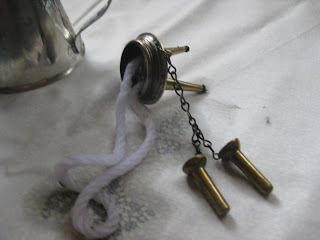 |
| Classic Overshirts on the Job image source unknown |
One of the best collections of Gold Rush daguerreotypes is found in the book "Silver & Gold" by Drew Johnson and Marcia Eymann, University of Iowa Press, 1998. I highly recommend it for anyone who is serious about studying California Gold Rush clothing.
From Gold Rush era advertisements to personal journals, I've gleaned only bits and pieces about overshirts with few details of their construction or ornament. The best period catalog illustration with decriptive text I've ever found is the REED, BROTHERS & CO. catalog of 1853, plate 19.
 |
| From My Copy of the 1853 Reed Catalog Showing the Miner's Frock and Descriptive Text photos by author 2012 |
So, even though none of the thousands of Gold Rush overshirts seem to have survived to the present day, you have to wonder, have any mid-19th century overshirts survived anywhere ? Yes indeedy......read on.
 |
| Original 1856 Overshirt Image Courtesy Steamboat Arabia Museum |
Years ago, during a visit to the Arabia Museum, the late Greg Hawley told us that they still had several untouched wool overshirts in frozen storage. You can imagine how excited I was, when I later heard that several of the shirts were being carefully conserved and would soon be available for public view. and that the museum's conservator Dr. Judy Wright, had posted before, during and after pictures on Facebook. The shirt, now designated as the "Border Ruffian Shirt" is also featured in a Youtube teaser promoting David Hawley's future Preservation Series of film shorts.
 |
| Inside View of Neck Slit During Reconstruction (note the gussets) Image Courtesy of Steamboat Arabia Museum and Dr. Judy Wright |
 |
| My Inspiration for the Latest Shirt Image Courtesy John McWilliams |
Excitied about all of this new-found evidence, I decided to replicate another Miner's Overshirt incorporating some of these "details" I had just discovered. True to my Gold Rush interest, I would base my shirt on an unpublished image of a young miner,shared with me, years ago by John McWilliams.
I already had some madder red, wool flannel, purchased from Burnley and Trowbridge. I'm really glad that Needle and Thread of Gettysburg PA still carries the Wooded Hamlet line as they had a perfect narrow wool soutache, that I dyed a royal blue. Remember the "bright colored braid" in the REED cataloge description? My wife is still my best source for small white china buttons, thank you very much Lindy.
 |
| My Replica |
Another thing worth noting in the Arabia shirt (and my replica), is that the front and back body are all one piece. This eliminates the need for a shoulder pieces to re-enforce a shoulder seam found with a two piece body.
 |
| Close-up Showing Faux Plastron ala Arabia and Patch Pockets |
 |
| Slit Opened, Showing Tapered Facing on the Left |
I also turned all of my seams twice to hide the raw edges, contrary to what the original shirt appears to have had. I felt the wool would contiue to unravel if it was left raw. Perhaps that wasn't a concern in the past. I did use a running stitch for the entire construction, even where I would have normally backstitched.
 |
| Small Gusset at Shoulder |
What I learned from this exercise was that maybe there is a place for simply constructed garments in the "Oh so carefully " reconstructed Living History world. I'm not sure if the Arabia overshirt is typical or atypical but it taught me to think about historic shirts in a different way as there's always "new" information to be discovered. My shirts will always be interpretations but hopefully reflective of a progressive approach to recreating history.
 |
| Close-up of Closed Neckline |







































